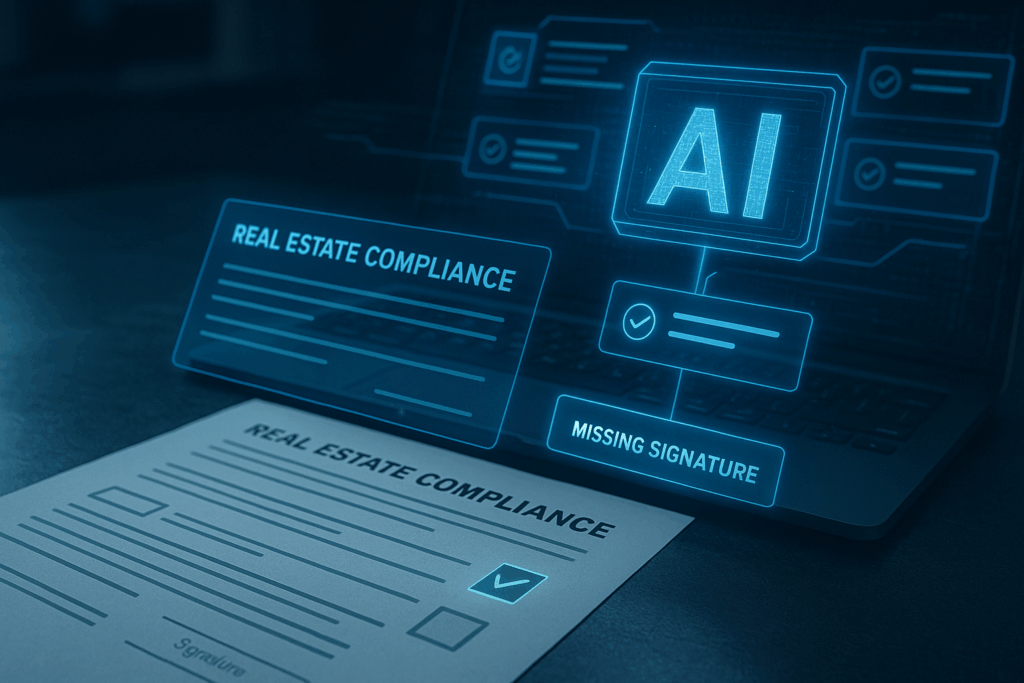AI real estate compliance is transforming how brokers manage risk, protect licenses, and save hours by catching errors before they become costly. Compliance is not why brokers get into real estate. Yet it is the one area that can cost you a deal, a reputation, or a license. One missing initial. One disclosure never uploaded. One earnest deposit with no proof in the file. These are small errors with outsized consequences.
Picture this: an agent hustles to close. The contract is executed, the inspection period flies by, counteroffers pile up. Everyone is “sure” the wire fraud disclosure was handled because “we always include it.” Three months later a complaint lands. The broker spends two days reconstructing a file, chasing signatures, and explaining why the compliance review happened after closing. No one acted in bad faith. A few items slipped. That is all it takes.
Manual review does not scale. Agents move fast. Coordinators juggle dozens of files. Brokers carry the responsibility for all of it. This is why AI is changing compliance. Not by replacing broker judgment, but by removing the thousand cuts that make errors inevitable.
Table of Contents
Why Compliance Is Harder Than Ever in 2025
- More documents. Wire fraud notices, agency disclosures, addenda, local forms. Each with signatures or initials in specific places.
- Stricter audits. Regulators want a verifiable, time-stamped trail of who reviewed what and when.
- Rising E&O sensitivity. Carriers look at control systems, exception rates, and documentation quality.
- Higher client expectations. Buyers and sellers assume digital order. Misses feel like negligence even when they are simple mistakes.
- Team complexity. New agents. Remote coordinators. Multiple offices. Consistency gets harder as you grow.
The net effect: more opportunities to miss something, with less margin for error.
What AI Real Estate Compliance Can Do for Brokers (Today)
AI is not a silver bullet. It is a tireless assistant. It does the boring work perfectly, so humans can do the important work well. Even the National Association of Realtors notes that artificial intelligence is rapidly shaping the future of real estate, from consumer experiences to compliance workflows.
- Detect missing signatures and initials. Page-level scans confirm all required marks exist where they should.
- Check document presence. If the checklist requires a wire fraud disclosure, AI confirms it exists. If it does not, the file cannot advance.
- Validate consistencies. Compare contract dates vs. addenda dates. Match buyer/seller names across documents. Flag mismatches.
- Track money milestones. Confirm proof of earnest deposit is uploaded within the defined window. Surface exceptions early.
- Enforce gates. Block submission to broker review until required items are complete. Reduce “please upload X” back-and-forth.
- Maintain audit trails. Time-stamp every action. Who uploaded. Who reviewed. What changed. When it changed.
Think of it as a preflight check. Files reach the broker already 95% clean. Broker time shifts from hunting for paperwork to making actual risk decisions. Other real estate technology providers have highlighted how AI-driven compliance tools are already catching missing documents and reducing audit risk across brokerages. The path is clear, integrating AI is becoming the standard for compliance.
What AI Should Not Do
- Interpret law. Local rules and edge cases still require broker judgment.
- Negotiate or advise clients. Empathy and context matter. Humans own client conversations.
- Override discretion. “Good enough” in a gray scenario is a leadership call, not a machine call.
AI narrows the error surface. You retain control.
The Hidden Cost of Human-Only Compliance
Human review alone creates three predictable problems:
- Throughput caps. One broker can only review so many pages per day. Growth hits a wall.
- Fatigue errors. The 47th page at 10:42 p.m. gets less attention than the 1st page at 9:00 a.m.
- Untracked exceptions. “We will fix it later” becomes “we forgot.” Audits expose these gaps.
The worst part? None of this is due to incompetence. It is due to volume. AI absorbs the volume.

How AI Real Estate Compliance Works (Under the Hood—Plain English)
- OCR + Layout Detection. The system reads PDFs. It recognizes where signature and initial blocks should appear based on form templates and learned patterns.
- Entity Matching. It matches names, dates, addresses, amounts, and timeline events across documents to spot inconsistencies.
- Checklist Mapping. Your state and brokerage items map to a structured list. Each item has criteria. The AI validates against those criteria.
- Confidence + Exceptions. When uncertain, the system flags the item for human confirmation rather than guessing.
- Immutable Logging. Every check creates an entry: what was checked, result, who resolved it, when it was resolved.
This is not “AI magic.” It is disciplined pattern recognition plus your defined rules. Beam.ai, for example, demonstrates how automated compliance agents can run preflight checks on documents, flagging exceptions before they reach a broker.
A Practical Rollout Plan: Adopting AI Real Estate Compliance in Your Brokerage
Phase 1: Define the Standard (1–2 weeks)
- Consolidate your current checklists into one master per transaction type (listing, buyer, dual).
- Mark each item Required, Conditional, or Optional.
- Attach acceptance criteria: “Initials on pages 2, 5, 7,” “Name match across contract + addendum,” “Proof of EM within 48 hours.”
Phase 2: Configure + Pilot (2–4 weeks)
- Load the master checklists into your system.
- Select a small team (1 TC, 2–3 agents, 1 broker) for live pilot.
- Track a baseline: first-pass approval rate, average review time, # of broker pings per file.
Phase 3: Train Agents on the New Flow (1 week)
- Show the “preflight” concept: AI catches misses before broker review.
- Emphasize the benefit: fewer interruptions, fewer “please upload X” messages.
- Provide a one-pager: “How to get green lights on first submit.”
Phase 4: Expand + Measure (4–6 weeks)
- Roll out to all teams.
- Set weekly metrics (see below).
- Tune rules where friction appears. Keep the gate strong. Remove noise.
Phase 5: Institutionalize
- Make AI preflight the default. No bypass without broker override.
- Review metrics monthly. Update checklists when forms change.
- Add a quarterly “file quality” review tied to coaching, not punishment.
Agent Workflow With AI: Fewer Interruptions, Faster Closings
- Before: Upload everything. Submit. Wait. Broker asks for three items. Resubmit. Wait again.
- After: Upload. The system highlights two missing initials and a missing disclosure. Agent fixes in minutes. Submit once. Broker approves quickly.
Result:
- Fewer Slack/Email pings.
- Less context switching.
- Better client experience (“We are cleared for compliance; let us close.”)

The Metrics That Matter (Track These)
- First-Pass Yield (FPY): % of files approved without rework. Target 70%+ within 60 days.
- Review SLA: Median hours from submission to broker approval. Target 24–48 hours depending on volume.
- Exception Rate: % of files with missing required items at submit. Drive down over time.
- Document Error Mix: Top three misses (e.g., missing initials, missing disclosure, EM proof). Use for training.
- Broker Time per File: Aim to reduce by 30–50%.
- Reopened Files Post-Close: Should approach zero.
When you show these trends to your E&O carrier, good things happen.
Security, Privacy, and Trust
- Data handling. Documents should be encrypted at rest and in transit.
- Access controls. Role-based permissions. Agent sees their file. Broker sees all. Auditors see read-only.
- Audit trail integrity. Logs must be tamper-evident.
- Data residency & retention. Clear policies your brokerage can explain to clients and regulators.
If your software cannot answer these questions, keep looking.
DIY Checklists vs. Traditional Software vs. AI-Assisted Compliance
| Approach | Strengths | Weaknesses | Best for |
|---|---|---|---|
| Spreadsheets/Manual | Cheap. Familiar. | No gates. No logs. High error risk. Broker time heavy. | Solo agents, temporary stopgaps. |
| Traditional Transaction Software | Centralized storage. Task lists. Sharing. | “Checklists,” not checks. Error detection minimal. Broker still hunts. | Small teams with low volume. |
| AI-Assisted Compliance (My Broker Cloud) | Preflight checks, gates, audit trails, summaries. Broker time cut. | Requires setup, change management. | Growing teams. Multi-office brokerages. Compliance-sensitive operations. |
If you are scaling, the choice is obvious.
FAQs: Straight Answers Brokers Want
Will AI real estate compliance replace broker review?
No. AI catches objective misses and streamlines the file. Brokers make the judgment calls.
How accurate is signature/initial detection?
Very high on standard forms. When confidence drops, items get flagged for human eyes. No blind trust.
Can AI handle state-specific forms?
Yes, with proper template mapping and checklist rules. Update rules when associations change forms.
What about custom brokerage requirements?
Add them. AI validates presence and placement like any other item.
Will regulators accept AI logs?
Regulators care about facts: was the document in the file, was it reviewed, when, by whom. Time-stamped logs answer those questions cleanly.
Does this slow agents down?
The opposite. Agents fix misses before review. Fewer interruptions. Fewer re-submits.
What if a document is handwritten or scanned poorly?
Low-quality scans reduce confidence. The system flags for human review. Coach agents to scan clearly.
How does this affect E&O?
Better controls and lower exception rates help your risk story. Some brokers report smoother renewals and better terms after tightening compliance.
What about privacy?
Use a platform with encryption, role-based access, and proper retention controls. Share your policy with clients.
Can I pilot without disrupting everything?
Yes. Start with one team, measure results, expand once the playbook is tight.
A Broker’s Playbook: 30-60-90 Day Change Plan
Days 1–30: Foundation
- Consolidate checklists.
- Configure rules and gates.
- Pilot on 5–10 live transactions.
- Publish a “Quick Start” for agents.
Days 31–60: Expansion
- Roll out to all agents.
- Track FPY, SLA, exception rate weekly.
- Hold two office hours sessions for Q&A.
Days 61–90: Optimization
- Tune high-noise rules.
- Add conditional checks for common edge cases.
- Lock the “no gate, no close” policy.
- Share before/after metrics with the team.
Make it normal. Make it boring. Make it automatic.
Where AI Real Estate Compliance Goes Next (2030 Outlook)
- Form-aware guidance. Live hints while agents fill forms, not after upload.
- Cross-system reconciliation. Contract numbers match title, lender, and accounting without manual checks.
- Predictive risk scoring. Files with higher miss probability surface early to the broker.
- Client-visible compliance steps. Your real estate client portal shows “what is complete, what remains, and why it matters,” reducing anxiety and inbound questions.
The direction is clear: fewer surprises, more transparency, faster, safer closings.
Why I Believe AI Compliance Is Non-Negotiable (Personal Note)
I’ve lived this problem from both sides. As a broker, I’ve stayed up late combing through files, flipping pages, and praying I didn’t miss a disclosure that could cost us a deal. I’ve seen good agents get blindsided because a missing signature wasn’t caught until it was too late.
That experience shaped how I think about compliance: it’s not optional, and it’s not just “paperwork.” It’s what protects your license, your reputation, and your future growth.
But here’s the truth — brokers shouldn’t have to carry that burden alone. The systems we used before left us doing the hardest part ourselves. That’s why I built My Broker Cloud: to give brokers a partner in compliance. Not just another checklist, but a tool that actually helps prevent mistakes before they reach your desk.
How My Broker Cloud Implements All of This
We built AI Compliance Assist inside My Broker Cloud because traditional tools left brokers doing the hard part: finding the misses. MBC changes the workflow:
- Custom checklists with hard gates. No submit without required items.
- AI preflight. Missing documents, signatures, and initials flagged instantly.
- Agent prompts. Fix issues at the source instead of ping-ponging with the broker.
- Review-ready summaries. Brokers see exactly what needs a decision.
- Complete audit trail. Every action, every review, time-stamped and searchable.
- Client portal, integrated payments, QuickBooks sync. Compliance in context. Operations that connect.
Our goal is simple: AI-enhanced compliance in a fraction of the time. Less stress for brokers. Smoother days for coordinators. Fewer interruptions for agents. Better experiences for clients.
Final Thoughts
Compliance will never be the reason you love this business. It is the reason you can keep building it.
You have two options:
- Keep throwing human hours at the problem and hope nothing slips.
- Put AI in front of the problem so the misses never reach you.
If you want files that arrive review-ready, if you want fewer late-night hunts for signatures, if you want a clean story for regulators and insurers, adopt AI compliance now. Your future self will thank you.

